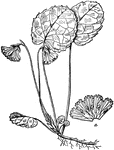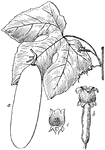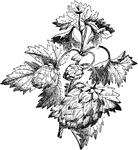
Hop
An illustration of the hop plant. Humulus, (hop) is a small genus of flowering plants, native to the…

Hound's Tongue
Cynoglossum officinale (hound's tongue, dog's tongue, gypsy flower, and rats and mice due to its smell)…

Vine
An illustration of vine foliage and inflorescence. An inflorescence is a group or cluster of flowers…

Self-Heal
"Self-heal. (Prunella vulgaris). The upper part of the stem with flowers. a, the calyx; b, the corolla;…

Jasminum grandiflorum
Jasminum grandiflorum (chameli in Hindi) is a species of jasmine native to South Asia. In India, its…
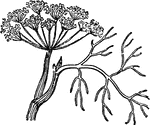
Dill
Dill (Anethum graveolens) is a short-lived perennial herb. It is the sole species of the genus Anethum,…

Duckweed Inflorescence
An illustration of duckweed inflorescence containing two male flowers each of one stamen and a female…
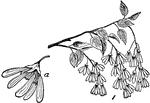
Canadian Serviceberry
A branch of the Canadian Serviceberry (Amelanchier canadensis), a shrub or small tree, showing flowers.

Sesame
The Sesame (Sesamum orientale, Sesamum indicum) is a flowering plant in the Pedaliaceae family of pedaliums…

Chay Root
The Chay Root (Oldenlandia umbellata) is a plant native to India used for the red dye that can be extracted…

Shepherd's Purse
"Plant with Flowers and Fruits of Shepherd's-purse" (Capsella bursa-pastoris) "a, flower; b, a pod."…
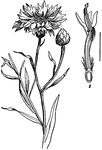
Cornflower
It is an annual plant growing to 40-90 cm tall, with grey-green branched stems. The leaves are lanceolate,…

Simarouba
"Branch of Simarouba amara, with female flowers. a, a male flower; b, a female flower." -Whitney, 1911

Blowout Grass
Blowout Grass (Redfieldia flexuosa) is a grass found on sand dunes. "a, spikelet; b, flower; c,…
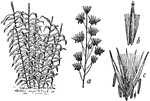
Giant Reed
"Bamboo-reed (Arundo donax). a, panicle; b, flowering scale, clothed with silky hairs; c, spikelet."…

Bulbous Buttercup
Ranunculus bulbosus, commonly known as St Anthony's turnip or bulbous buttercup, is a perennial weed…

Lamium Album
Lamium album (White Deadnettle) is a flowering plant in the family Lamiaceae, native throughout Europe…
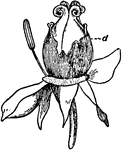
Peony Bud
Paeonia) is the only genus in the flowering plant family Paeoniaceae. They are native to Asia, southern…

Foxglove
An illustration of: 1, Coralla cut open showing the four stamens; 2, Unripe fruit (lengthwise); 3, ripe…

Sedum
Sedum is the large stonecrop genus of the Crassulaceae, representing about 400 species of leaf succulents,…

False Rue Anemone
The plant and fruit of the False Rue Anemone (Isopyrum biternatum). It is a flowering plant in the Ranunculaceae…
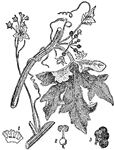
Bryony
Bryony is the common name for any of twelve species in the genus Bryonia. These are perennial, tendril-climbing,…

Sagebrush
"Pasture Sage-brush (Artemisia frigida). a, leaf; b, flower-head; c, fertile flower; d, marginal flower."…

Canadian St. John's Wort
"Canadian St.-John's-wort (Hypericum Canadense). a, leaf; b, seed-capsule." -Whitney, 1911

Marsh St. John's Wort
"Marsh St.-John's-wort (Triadenum Virginicum). a, flower; b, seed-capsule." -Whitney, 1911
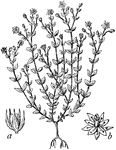
Thyme-Leaved Sandwort
"Thyme-leaved Sandwort (Arenaria serpyllifolia). a, capsule surrounded by the scarious calyx; b, expanded…

Façade Tile from the Temple of Diana at Ephesus
On the apex and two lower angles of the pediment were introduced acroteria, sometimes ornaments of flowers…
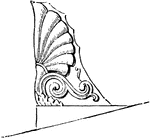
Acroteria, or Roof-Pedestal, from the Temple of Theseus at Athens
On the apex and two lower angles of the pediment were introduced acroteria, sometimes ornaments of flowers…
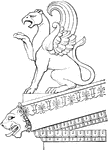
Acroteria from the Temple of Minerva at Ægina
On the apex and two lower angles of the pediment were introduced acroteria, sometimes ornaments of flowers…
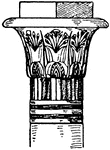
Egyptian Capital
The Egyptian capital is the upper termination of the column with opened papyrus flowers. It is found…
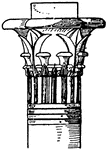
Egyptian Capital
The Egyptian capital is the upper termination of the column with opened papyrus flowers. It is found…
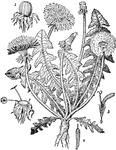
Dandelion
Taraxacum is a large genus of flowering plants in the family Asteraceae. They are native to Europe,…
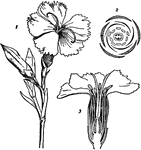
Dianthus
Dianthus is a genus of about 300 species of flowering plants in the family Caryophyllaceae, native mainly…
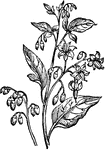
Bittersweet
The Bittersweet (Solanum dulcamara) is a perennial vine in the Solanaceae family of nightshades.
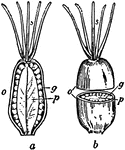
Cashew Tree
An illustration of various parts of the cashew tree. "1, Branch, bearing flowers and fruit. The fruit…
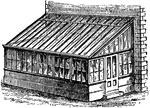
Plant House
A lean-to plant house which is associated with the growth of ornamental plant and flowers.
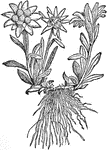
Edelweiss
Edelweiss (Leontopodium alpinum) is a European mountain flower of the Asteraceae or daisy family.

Oleaster
"Flowering Branch of Oleaster (Elaeagnus angustifolia). a, fruit; b, section of same." -Whitney, 1911

elecampane
The Elecampane (Inula helenium) is a flowering plant in the Asteraceae family of daisies.

Myrtle
The Myrtle (Myrtus) is a genus of one or two species of flowering plants in the family Myrtaceae, native…

Carrot Flower
An illustration of the inflorescence of the carrot plant. An inflorescence is a group or cluster of…
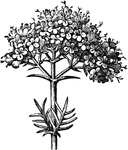
Valerian Inflorescence
Valerian is a hardy perennial flowering plant, with heads of sweetly scented pink or white flowers.…

Valerian Flower
Valerian is a hardy perennial flowering plant, with heads of sweetly scented pink or white flowers.…

Valerian Flower (Longitudinal Section)
An illustration of a longitudinal sectional view of the valerian flower. Valerian is a hardy perennial…

Valerian Seed with Pappus
An illustration of the valerian seed with attached pappus. In a composite flower, Pappus is the part…
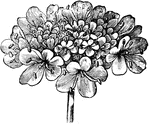
Inflorescence of Field Scabious
An illustration of the inflorescence of the field scabious. Knautia arvensis, commonly known as Field…
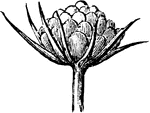
Young Inflorescence of Field Scabious
An illustration of the young inflorescence of the field scabious. Knautia arvensis, commonly known as…

Ray-floret of Field Scabious
An illustration of a ray-floret of the field scabious. Knautia arvensis, commonly known as Field Scabious,…

Ray-floret of Field Scabious
An illustration of a ray-floret of the field scabious. Knautia arvensis, commonly known as Field Scabious,…

Seed of Field Scabious
An illustration of the seed of the field scabious. Knautia arvensis, commonly known as Field Scabious,…

Comfrey
Comfrey (also comphrey) is an important herb in organic gardening, having many medicinal and fertilizer…

Comfrey Flower
Comfrey (also comphrey) is an important herb in organic gardening, having many medicinal and fertilizer…

